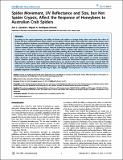Por favor, use este identificador para citar o enlazar a este item:
http://hdl.handle.net/10261/128880COMPARTIR / EXPORTAR:
 SHARE SHARE
 CORE
BASE CORE
BASE
|
|
| Visualizar otros formatos: MARC | Dublin Core | RDF | ORE | MODS | METS | DIDL | DATACITE | |

| Campo DC | Valor | Lengua/Idioma |
|---|---|---|
| dc.contributor.author | Llandres, Ana L. | es_ES |
| dc.contributor.author | Rodríguez-Gironés, Miguel Ángel | es_ES |
| dc.date.accessioned | 2016-02-09T08:51:17Z | - |
| dc.date.available | 2016-02-09T08:51:17Z | - |
| dc.date.issued | 2011-02-16 | - |
| dc.identifier.citation | PLoS ONE 6 (2): e17136 (2011) | es_ES |
| dc.identifier.uri | http://hdl.handle.net/10261/128880 | - |
| dc.description.abstract | According to the crypsis hypothesis, the ability of female crab spiders to change body colour and match the colour of flowers has been selected because flower visitors are less likely to detect spiders that match the colour of the flowers used as hunting platform. However, recent findings suggest that spider crypsis plays a minor role in predator detection and some studies even showed that pollinators can become attracted to flowers harbouring Australian crab spider when the UV contrast between spider and flower increases. Here we studied the response of Apis mellifera honeybees to the presence of white or yellow Thomisus spectabilis Australian crab spiders sitting on Bidens alba inflorescences and also the response of honeybees to crab spiders that we made easily detectable painting blue their forelimbs or abdomen. To account for the visual systems of crab spider’s prey, we measured the reflectance properties of the spiders and inflorescences used for the experiments. We found that honeybees did not respond to the degree of matching between spiders and inflorescences (either chromatic or achromatic contrast): they responded similarly to white and yellow spiders, to control and painted spiders. However spider UV reflection, spider size and spider movement determined honeybee behaviour: the probability that honeybees landed on spider-harbouring inflorescences was greatest when the spiders were large and had high UV reflectance or when spiders were small and reflected little UV, and honeybees were more likely to reject inflorescences if spiders moved as the bee approached the inflorescence. Our study suggests that only the large, but not the small Australian crab spiders deceive their preys by reflecting UV light, and highlights the importance of other cues that elicited an antipredator response in honeybees. | es_ES |
| dc.description.sponsorship | This work was supported by the Spanish Ministry of Science and Technology (project CGL2007-63223 to MARG) and CSIC (project PIE 2006 3 OI 073 to MARG and studentship I3P-BPD2005 to ALL). | es_ES |
| dc.language.iso | eng | es_ES |
| dc.publisher | Public Library of Science | es_ES |
| dc.rights | openAccess | es_ES |
| dc.title | Spider Movement, UV Reflectance and Size, but Not Spider Crypsis, Affect the Response of Honeybees to Australian Crab Spiders | es_ES |
| dc.type | artículo | es_ES |
| dc.identifier.doi | 10.1371/journal.pone.0017136 | - |
| dc.description.peerreviewed | Peer reviewed | es_ES |
| dc.identifier.e-issn | 1932-6203 | - |
| dc.contributor.funder | Ministerio de Ciencia y Tecnología (España) | es_ES |
| dc.relation.csic | Sí | es_ES |
| dc.identifier.funder | http://dx.doi.org/10.13039/501100006280 | es_ES |
| dc.identifier.pmid | 21359183 | - |
| dc.type.coar | http://purl.org/coar/resource_type/c_6501 | es_ES |
| item.cerifentitytype | Publications | - |
| item.openairecristype | http://purl.org/coar/resource_type/c_18cf | - |
| item.grantfulltext | open | - |
| item.openairetype | artículo | - |
| item.fulltext | With Fulltext | - |
| item.languageiso639-1 | en | - |
| Aparece en las colecciones: | (EEZA) Artículos | |
Ficheros en este ítem:
| Fichero | Descripción | Tamaño | Formato | |
|---|---|---|---|---|
| PlosOne.Llandres.Rodriguez-Girones.pdf | 833,21 kB | Adobe PDF |  Visualizar/Abrir |
CORE Recommender
PubMed Central
Citations
9
checked on 21-abr-2024
SCOPUSTM
Citations
33
checked on 23-abr-2024
WEB OF SCIENCETM
Citations
28
checked on 23-feb-2024
Page view(s)
196
checked on 26-abr-2024
Download(s)
221
checked on 26-abr-2024
Google ScholarTM
Check
Altmetric
Altmetric
Artículos relacionados:
NOTA: Los ítems de Digital.CSIC están protegidos por copyright, con todos los derechos reservados, a menos que se indique lo contrario.
